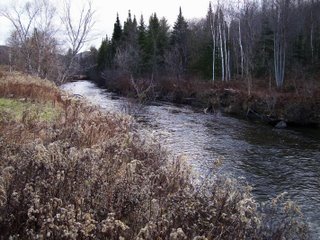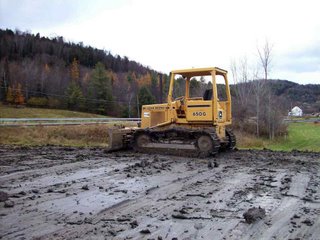
Gail had planned to go to Montpelier today to do errands but the morning gave rise to a snowfall of light, dry snow. The roads even here didn't seem too safe so she decided to stay home and I decided to head downtown to load up some more brush.
I don't think most folks understand how a little clean-up can provide a different visual effect within your garden, regardless of its size. I drove off Route 2 and onto the property, made a wide circle along the Winooski River and came to a stop at the height of the land with the truck parallel to Route 2 but facing towards Marshfield Village. The view impressed me and made me enjoy our purchase even more.
For a couple-three weeks now I have been clearing dead trees and brush while trying to understand the land better. There's plenty to learn. My point is that a real messy looking piece of property can command a much better selling price if only it's cleaned up a bit. I have removed something like 20 pick-up truck loads of brush so the entire image is much different now. It makes everything look bigger and lets you know what you have and where the boundaries are.
Dragging brush through grass and goldenrod stalks, hops and grapevines, woodvine and blackberry bushes is not pleasant. You kind of feel relieved when the truck is loaded. At the same time you wish you had some kind of levitation power like you see in the movies to unload the debris where you want. I have yet to acquire that skill.
For as long as I have loaded trucks, I have had a habit of walking around the loaded vehicle to be sure I haven't left anything behind. Driving something that suddenly has lost visibility out the back window and gained a payload at the same time deserves a safety check. When I made the circle today, a view of the Winooski River caught my attention and I headed for it. A couple red squirrels sat above me, eating butternuts. One sat back on his tail and almost pointed his nose toward the river.

As I walked along the riverbank, mellowed by the sound of the flowing water, I was suddenly pleased to find a dried, 6 foot tall stalk from a Lilium canadense. It was seedless on top and looked little like the beautiful candelabra lily that often welcomes Vermonters close to Independence Day. I have trained myself to look for plants at different times of the year and today the training paid off. I looked around, making a note in my mental diary for next spring and summer.
There is variation in L. canadense and although spotted, creamy orange is the predominant color around here, there are some reds and red/yellows. I have been asked to look out for clear, unspotted lighter colored orange but I have never found one without spots. Finding a red L. canadense is like finding a nice arrowhead along the Lemon Fair River in Middlebury. Your heart skips a beat and you smile even if you don't know it.

Riverbanks are ideal places for these lilies because the soil is usually replenished each year with a new layer washed down from above. The annual changes help disperse the seeds and on occasion when spring runoff is especially forceful, whole bulb parts head for Lake Champlain. If you find one Lilium canadense, it's likely you'll find more in fairly close proximity. Your "finds" won't necesarily be in bloom but over time you'll be able to enjoy them every time you return to the site.

There a several things working against lilies now. There is a lily leaf beetle like the one in this picture from the University of Rhode Island. This beetle has been around a long time but only this past year did we find any in our gardens. I suspect they may have been here last year but went unnoticed. They seem to arrange lily varieties in order of preference for dinner, something like poached salmon goes here and boiled spinach goes there. Asiatic lilies seem to top the lily list but the species like L. canadense seem less of interest. It's still early to assess the long term ramifications but clearly the lily leaf beetle is of concern.
Deer rank number two and are the most current danger in my opinion. Every year the number of hunters declines, the number of new homes increases and the amount of land disrupted for construction grows. Deer seek out easy meals and I have seen them eat lily stems to the ground when I am 20 yards away watching then.
The final threat seems to be from the plant world itself and from some of the more primitive plants, the ferns. The lily in the next picture is doing well on a bank of the Winooski River surrounded by three varieties of fern. Ferns can take over an area in a few years and some with more significant root systems probably interfer with growth in subsequent years. I haven't studied these to the point of affirming that the bulb production is deterred by fern competition but I think I'm accurate.

Although I mention the nemeses of my favorite lilies, it's out of admiration for them that I think about how to protect them. Finding one that will stand so tall next summer, made my day. I hope you will get a chance to see some yourself next year.
Writing from the mountain above Peacham Pond where wind, blowing snow and a temperature of 20 degrees reminds Karl, the wonderdog, that life by the woodstove is not bad.
Best gardening wishes for 2007!
George Africa
http://vermontflowerfarm.com
http://thevermontgardener.blogspot.com



























